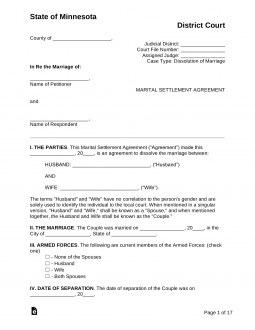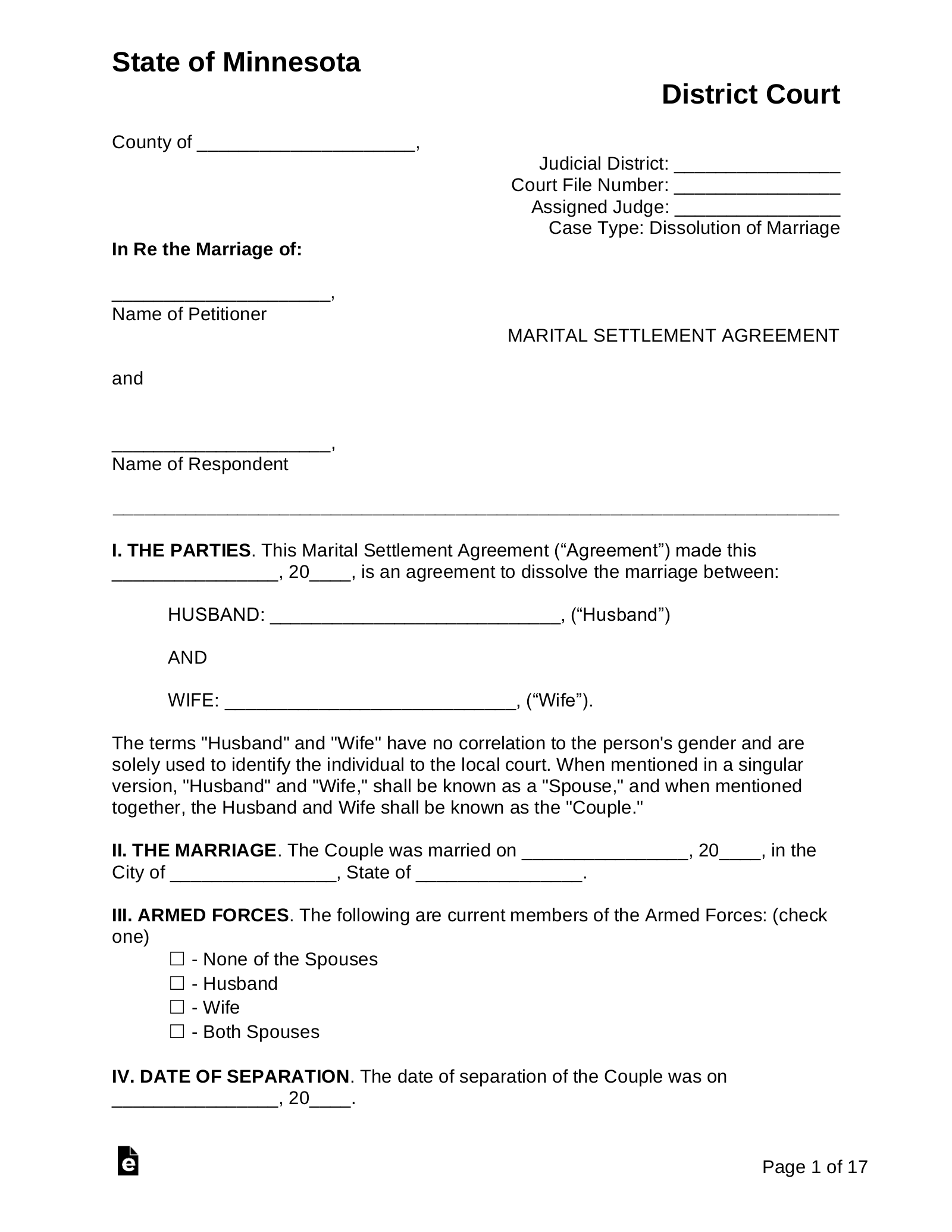Updated September 01, 2023
A Minnesota marital settlement agreement is a legally binding contract between spouses that lists the terms of their divorce (legally known as “dissolution of marriage”). The document addresses the division of personal property, real estate, assets, and debts, as well as the custody of any children. Under the contract, one (1) spouse may be given financial support in the form of alimony and child support payments made by the other party over a limited period. Entering into a marital settlement agreement prior to the finalization of their divorce allows couples to avert a lengthy and costly court process. In many cases, couples will require legal mediation to agree on terms that are fair for both parties and in the best interests of their children (if applicable).
Table of Contents |
Divorce Laws
Statutes – Minnesota Statutes – Domestic Relations, Chapter 518 (Marriage Dissolution)
Alimony (§ 518.552) – In a divorce case, the court may grant an order for alimony (the legal term is “maintenance”) to be paid to either party. The amount and schedule for the maintenance payments will be determined based on the spouse’s property, established standard of living, educational needs, ability to support themselves, and custody of children.
Alimony Calculator – calculators.law
Child Support (§ 518.17 (Subd. 1)) – If a divorcing couple has children, one (1) spouse will usually be awarded child support in accordance with the child’s needs and well-being, as determined by the court (see Child Support Guidelines).
Child Support Calculator – Minnesota Department of Human Services
Division of Property (§ 518.58) – Minnesota is an equitable distribution state, which means that the court will divide marital property in the most “just and equitable” manner possible rather than the most equal. The court will make its determination based on the following factors:
- Length of the marriage
- The age, health, occupation, income, and employability of each party
- The assets and debts of each party
- The income potential of each party
- Each party’s contribution to the acquisition, preservation, and depreciation/appreciation in value of marital property
- The contribution of each spouse as a homemaker
Grounds for Divorce (§ 518.06 (Subd. 1)) – In Michigan, there are no fault-based grounds for divorce. The only requirement is for couples to prove that there has been an irretrievable breakdown of their marriage.
Interim Support (§ 518.62 and § 518.131 (Subd. 1)(b) and (c)) – Upon submitting a motion, either party may apply to receive temporary alimony and/or child support while their case is pending.
Residency (§ 518.07) – To file for divorce in Minnesota, a couple must meet at least one (1) of the following residency requirements:
- One (1) spouse has been a resident of the state for at least one-hundred eighty (180) days
- One (1) spouse has been stationed as an armed services member in the state for at least one-hundred eighty (180) days
- One (1) spouse has been in a state care facility for at least one-hundred eighty (180) days
- The couple was married in the state
- The couple’s state of residence doesn’t allow them to divorce due to their sexual orientation/gender identification
Divorce Forms
- Where to File – District Court in County of Residence
- Filing Fee – $285
- How Long Does it Take? At least thirty (30) days

Uncontested Divorce with No Children:
- Joint Petition, Agreement, and Judgment and Decree for Marriage Dissolution Without Children
- Confidential Information Form (Form 11.1)
- Confidential Financial Source Documents (Form 11.2)
- Notice to Public Authority
- Affidavit of Service to Public Authority
- Certificate of Dissolution
- Affidavit for Proceeding In Forma Pauperis (IFP)
- Notice of Entry (Delivered to petitioners by the court after a judgment has been entered)
- Summary Real Estate Disposition Judgment (SREDJ)
Uncontested Divorce With Children
- Joint Petition, Agreement, and Judgment and Decree for Marriage Dissolution With Children
- Confidential Information Form (Form 11.1)
- Confidential Financial Source Documents (Form 11.2)
- Notice to Public Authority
- Affidavit of Service to Public Authority
- Certificate of Dissolution
- Affidavit for Proceeding In Forma Pauperis (IFP)
- Notice of Entry (Delivered to petitioners by the court after a judgment has been entered)
- Summary Real Estate Disposition Judgment (SREDJ)
Couples can also use the online Minnesota Guide & File program to fill out the forms they need to file their divorce case.
How to File for Divorce in Minnesota (5 steps)
- Complete and File Joint Petition for Dissolution of Marriage Paperwork
- Notice to Public Authority
- Decree and Certificate of Dissolution
- Summary Real Estate Disposition Judgment (SREDJ)
- Name Change
1. Complete and File Joint Petition for Dissolution of Marriage Paperwork
If a couple meets state residency requirements and is in agreement regarding the terms of their divorce, they can file for an uncontested divorce by completing and filing the Joint Petition, Agreement, and Judgment and Decree for Marriage Dissolution form (Without Children / With Children), which must be signed by both parties.
The joint petition includes the couple’s marital settlement agreement, however, supplemental pages may be added to provide for any other interests that the couple would like to be included. If either spouse is not in agreement on any of the divorce’s terms, the couple will need to file for a contested divorce which involves serving the opposing party and more extensive litigation than an uncontested one. Couples may alter the petition to suit their situation; however, they cannot remove any paragraphs. The following additional documents must also be completed by each party and attached to the petition:
The couple will need to file the completed paperwork with the clerk of the district court for the county in which either spouse is a resident. They will be charged a minimum filing fee of $285. This fee may be waived if the parties complete and file an Affidavit for Proceeding In Forma Pauperis (IFP) with their petition.
2. Notice to Public Authority
If either party currently receives or plans to apply for public assistance, they are required by law to notify the related assistance provider of their divorce by serving them with a Notice to Public Authority by hand-delivery or mail. Once the notice has been served, the petitioner will need to fill out an Affidavit of Service to Public Authority and file it with the clerk of the court.
3. Decree and Certificate of Dissolution
A minimum of thirty (30) days from the date that the petition was filed and after the court has reviewed the couple’s petition, both parties will receive a Notice of Entry of a Decree of Dissolution in the mail, at which point the divorce is finalized and the couple becomes legally divorced. A Certificate of Dissolution, signed by a judge, can also be obtained from the court by either party upon paid request.
4. Summary Real Estate Disposition Judgment (SREDJ)

If either party in a Petition for Dissolution for Marriage owns real estate, they will be required to fill out a Summary Real Estate Disposition Judgment (SREDJ) form for each piece of real property (see Instructions). The purpose of this form is to give proof of divorce and update county records regarding each spouse’s interest in their real estate. Once completed, this form must be filed with the court in which the divorce case was filed and signed by the judge. A certified copy must be requested by the real estate owner and filed with the County Recorder.
5. Name Change

Either spouse may request to have their name legally changed in their original divorce petition. The name change will be reflected in the Decree and Certificate of Dissolution, certified copies of which can be used to update the individual’s identification and records. Under Minnesota law, any name may be chosen as long as it is requested without an intent to defraud or mislead. For someone to change their name after a divorce has taken place, they will need to file an Application for Name Change with their local district court.


